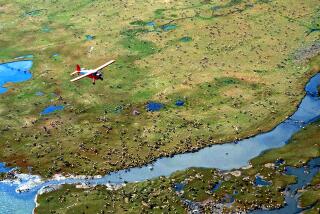Alaska Offers Countless Ways to Vanish
ANCHORAGE — Eric Miller wrestles with opposing theories about his brother’s disappearance. Either he died in the Alaska wilderness or he ran away -- or both.
Jim Miller, 39, left his Anchorage home Sept. 22 in the midst of personal problems, including pending heart surgery. His car was found about three weeks later in the parking lot of Resurrection Pass Trail, a popular hiking route in the Chugach National Forest south of Anchorage.
But intensive searches turned up no sign of the experienced outdoorsman other than unconfirmed sightings.
“Nothing panned out,” Eric Miller said. “What’s left now is the feeling that we’ll never see him again.”
Alaska’s 586,000 square miles afford countless ways to get lost, whether by fate or design. It’s easy to fall prey to the state’s unforgiving terrain and severe weather, according to those in the business of searching.
Miller is among 3,780 people reported missing in Alaska this year and one of the 219 who remain missing, according to the Missing Persons Clearinghouse maintained by Alaska state troopers. The clearinghouse is a repository of data submitted by law enforcement agencies throughout the state.
The great majority of cases involve young runaways who eventually turn up alive, said investigator Bill Hughes, who manages the clearinghouse. Others are lost hikers and snowmobilers, commercial fishermen lost at sea and plane crash victims whose remains have not been found.
Then there are the people who are not really lost. They’ve either chosen to start anew in one of Alaska’s remote villages or they’ve neglected to contact relatives living outside.
“One man didn’t want to be found,” Hughes said. “He finally agreed to call his mother when I told him, ‘Look, if you don’t call her, I’ll have to file a big report.’ ”
More than 53,000 people have been reported missing in the state since the clearinghouse was established in 1988. Of those, 1,027 are still listed as missing.
Their stories are represented by color-coded flags dotted across an Alaska map in Hughes’ office.
Included are black flags, which mark locations where unidentified human remains have been found.
One such recent find -- a human foot inside a shoe discovered in northwestern Alaska -- is being sent to the FBI’s new National Missing Person DNA Database at its Quantico, Va., academy.
Alaska authorities are also sending saliva samples from relatives of three missing fishermen involved in a boating accident in the area a few years ago. The samples could provide a DNA link to the missing.
Some of Alaska’s unsolved missing persons cases are detailed on the trooper clearinghouse Web site.
There’s Maryellen McMillin, who disappeared from her Fairbanks home with her green Subaru station wagon in November 1998. Sabine Duellmann, a German national who vanished soon after landing in Anchorage on a United Airlines flight in 1998. Charlie Chocknok, an elderly Yupik Eskimo last seen walking near the New Stuyahok village airport in July 2000.
Troopers say Chocknok, 84 at the time, had talked about visiting Dillingham 43 air miles to the south, but he never made it on any flights. Because of senility, he might have set out on foot, only to encounter a bear or fall into the nearby Nushagak River, although a thorough search of the area turned up no sign of either.
“People are swept away in the river and their bodies are never found, so it can’t be ruled out,” Trooper Mike Brandenburger said. “Water conditions are colder here and body gases don’t develop at the same speed as in the Lower 48, so bodies tend to sink.”
The elements can change with amazing speed, particularly in colder seasons.
Jim Miller, the Anchorage outdoorsman, vanished as trees lost their leaves, creating a ground cover thick enough to hide valuable clues from even the keenest eyes, said Trooper Sgt. Keith Mallard, who has participated in scores of searches.
“The weather can sneak right up on you,” Mallard said. “If you’re not prepared for the weather or the harshness of the environment, a twisted ankle can put you into an emergency situation.”
Some remote communities rely on trail markers to guide snowmobilers and other travelers during winter, when whiteout conditions can erase familiar landmarks.
In the Yukon-Kuskokwim delta, in western Alaska, the Bethel Search and Rescue group puts up color-coded markers. White and orange indicate a good trail. Red means a rough ice road. Blue signifies thin ice or open water, and green a nearby shelter.
The colors are marked on poles lining trails between villages commonly used by residents who travel around the region.
“Out there, it can go from clear one hour to zero visibility the next,” said Peter Atchak, Search and Rescue leader. “Even people who know the terrain and conditions can become disoriented. But experienced ones learn to stay put and equip themselves with survival gear.”
Survival was a skill that Jim Miller had honed since childhood, when his family lived briefly in tents and wilderness cabins in northern Washington state and eastern interior Alaska.
It’s one reason that Eric Miller will always wonder about his brother’s fate.
“Finding his body would be a relief at this point,” he said. “But we may never get to know what happened to him.”
More to Read
Sign up for Essential California
The most important California stories and recommendations in your inbox every morning.
You may occasionally receive promotional content from the Los Angeles Times.










